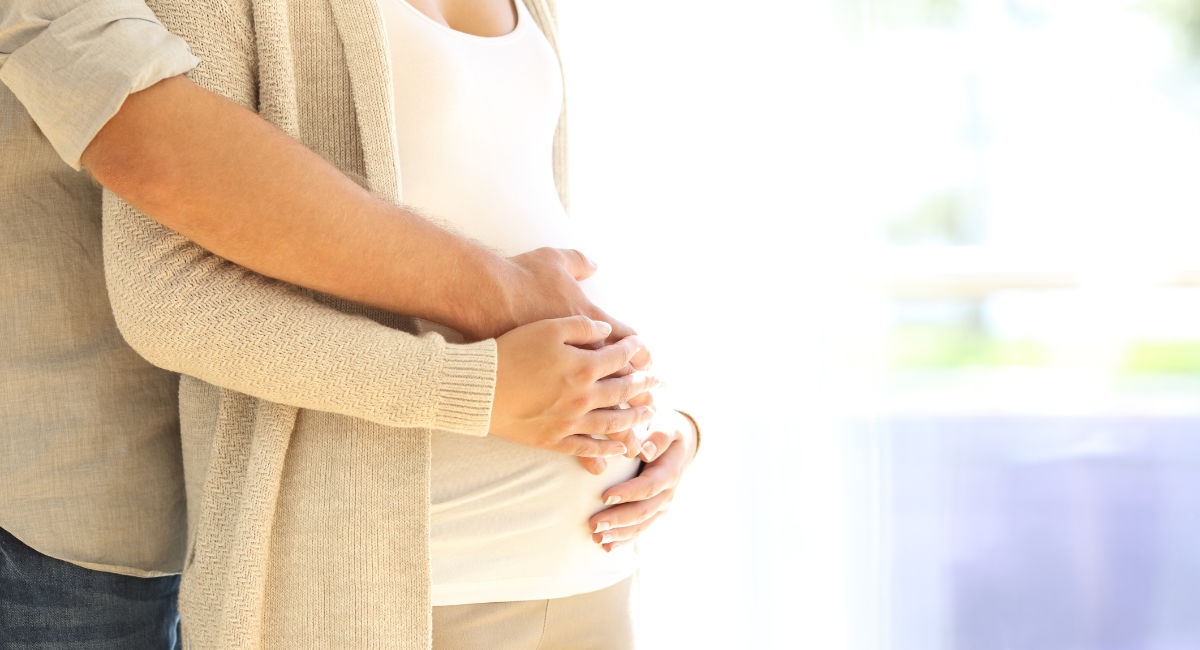Recently released data from the Centers for Disease Control and Prevention (CDC) for 2020 reveals that unmarried women have nearly nine times as many abortions as married women. This data confirms older data published by Planned Parenthood’s former “special affiliate,” the Guttmacher Institute, and is similar to what has been reported in past years. It also revealed that women in their 20s have the most abortions, and women of color continue to have disproportionately high rates of abortion.
Majority of abortions committed on women who are unmarried
In 2020, the CDC reported data on the marital status of women who had 497,786 abortions among 40 reporting areas.
The data, which excluded “12 reporting areas (California, Connecticut, the District of Columbia, Hawaii, Maryland, Massachusetts, Nevada, New Hampshire, New York State, Tennessee, Washington, and Wyoming) that did not report, did not report by marital status, or did not meet reporting standards,” found that 13.7% of women who obtained an abortion were married, while a whopping 86.3% were unmarried.
“The abortion ratio was 46 abortions per 1,000 live births for married women and 412 abortions per 1,000 live births for unmarried women,” the CDC wrote. This means that for every 100 live births, married women aborted 4.6 babies while unmarried women aborted just over 41.2 preborn children. In other words, unmarried women will abort 8 to 9 times more babies than their married counterparts.
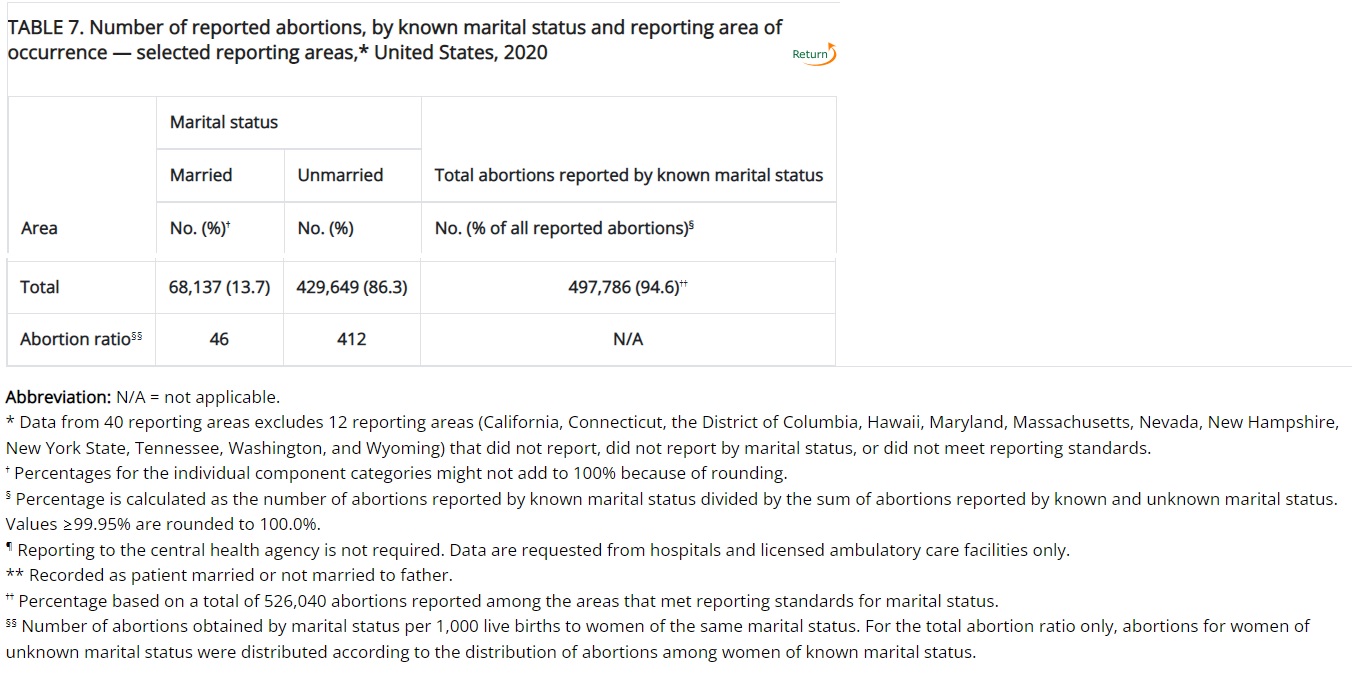
Majority of abortions on unmarried women in 2020
Older data compiled by Guttmacher researchers for 2014 also found that never-married women accounted for the largest proportion of abortions (45.9%) and had an abortion rate of 16.9 per 1000.
“Women cohabiting with but not married to their partners had the highest abortion rate: 31.0 per 1000. Between 2008 and 2014, declines in abortion were most pronounced for cohabitating women (39%) and lowest for married women (21%), although the latter group had a low abortion rate in both periods,” Guttmacher noted.
Women in their 20s accounted for more than half of abortions
“Among the 48 areas that reported abortion numbers by women’s age for 2020, women in their 20s accounted for more than half of abortions (57.2%),” the CDC wrote in 2020. The report noted, “Women aged 20–24 and 25–29 years accounted for the highest percentages of abortions (27.9% and 29.3%, respectively) and had the highest abortion rates (19.2 and 19.0 abortions per 1,000 women aged 20–24 and 25–29 years, respectively).”
The categories showed the following percent of abortions:
- Under 15 – .2%
- 15-19 – 8.2%
- 20-24 – 27.9%
- 25-29 – 29.3%
- 30-34 – 19.9%
- 35-39 – 10.7%
- 40 or older – 3.7%
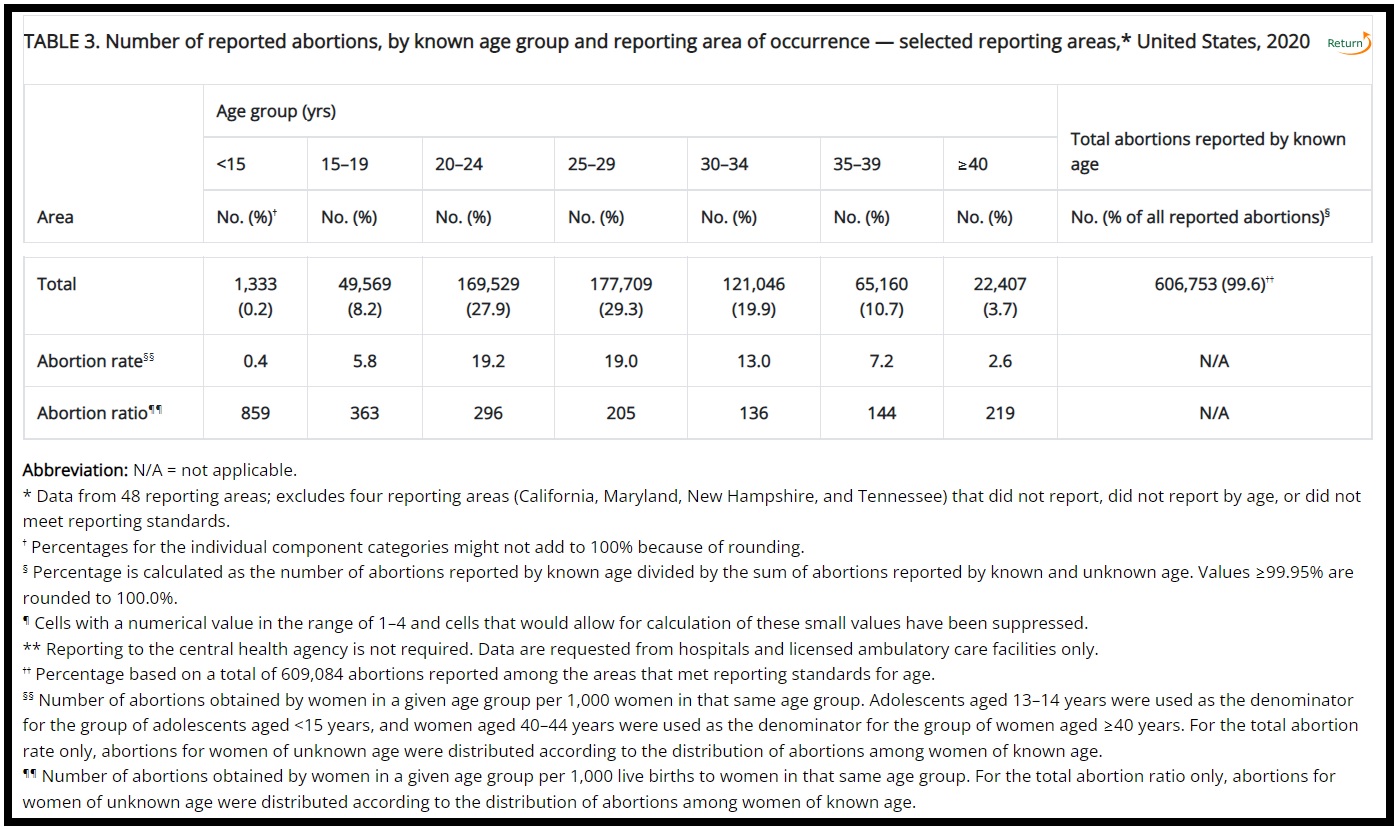
Women in 20’s have highest abortion rates CDC 2020
“By contrast, adolescents aged <15 years and women aged ≥40 years accounted for the lowest percentages of abortions (0.2% and 3.7%, respectively) and had the lowest abortion rates (0.4 and 2.6 abortions per 1,000 women aged <15 and ≥40 years, respectively). However, abortion ratios were highest among adolescents (859 and 363 abortions per 1,000 live births among those aged <15 years and 15–19 years, respectively) and lowest among women aged 25–39 years (205, 136, and 144 abortions per 1,000 live births among those aged 25–29, 30–34, and 35–39 years, respectively),” the CDC also reported.
This seems to line up with previous data from the Guttmacher Institute which reported that in 2014, more than half of all U.S. abortion patients — 60% — were in their 20s, while 25% were in their 30s.
“The proportion of abortion patients who were adolescents declined 32% between 2008 and 2014,” a separate Guttmacher report stated, adding that “… the proportion accounted for by 15–17-year-olds declined 44% over this period, and that among 18–19-year-olds dropped by 25%.”
Abortions on women with no previous ‘live birth’ much less than those who had born children
Of the 506,696 abortions reported from 43 areas which categorized previous live births, 39.1% had no previous live births while nearly 61% had experienced one or more previous live births.
The CDC reported:
- No previous live births: 198,099 (39.1%)
- One previous live birth – 124,312 (24.5%)
- Two previous live births – 102,682 (20.3%)
- Three previous live births – 49,026 (9.7%)
- Four or more previous live births – 32,643 (6.4%)
The data excluded “nine reporting areas (California, Connecticut, the District of Columbia, Illinois, Maryland, New Hampshire, New York State, Tennessee, and Wisconsin) that did not report, did not report by number of previous live births, or did not meet reporting standards,” the CDC stated.
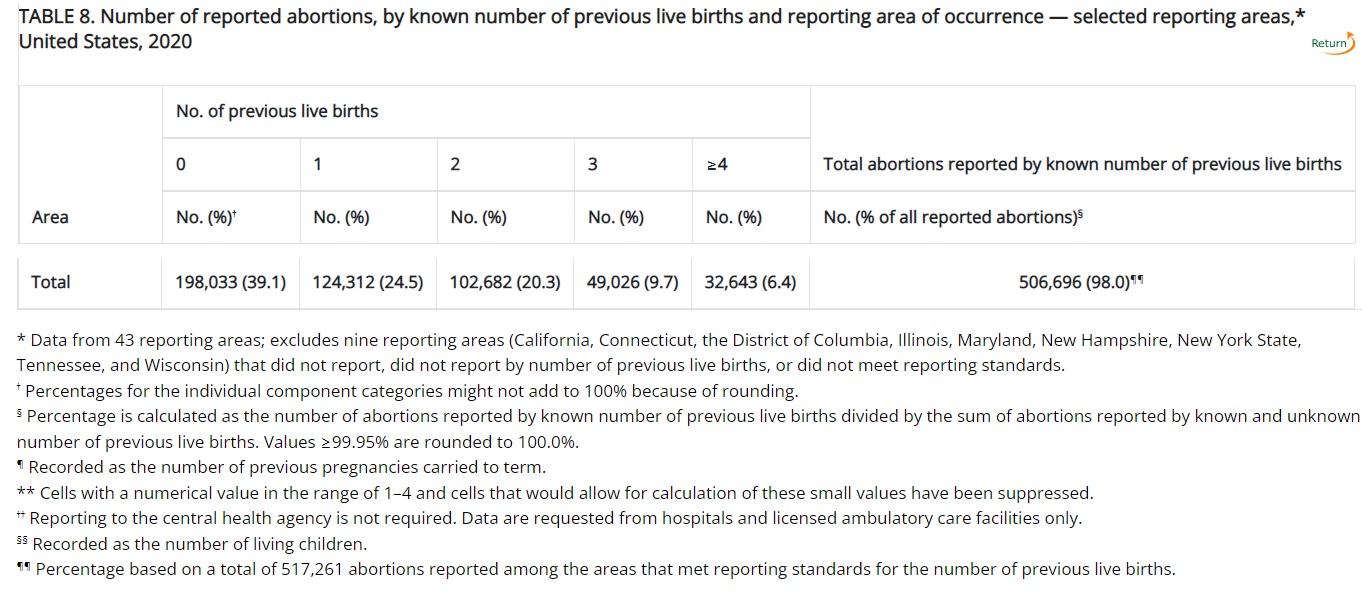
CDC 2020 abortion data on previous live births
In 2014, data from Guttmacher indicated that 59% of women obtaining abortions had previously had a live birth.
Live Action News previously reviewed a study which analyzed a population approximately 583 times larger than the sample used by Guttmacher. This study found that abortion among low-income women who have had previous children is “exceedingly uncommon, if not rare.”
Majority of abortions happen on women who never had a previous abortion
Repeat abortions are a growing problem, especially as it becomes easier to obtain the abortion pill.
In 2020, while the CDC found that the majority (57.7%) of the 503,178 abortions recorded from 42 areas were first-time abortions, it also found that over 40% were repeat abortions, including:
- One previous abortion: 121,301 (24.1%)
- Two previous abortions: 52,788 (10.5%)
- Three previous abortions: 38,999 (7.8%)
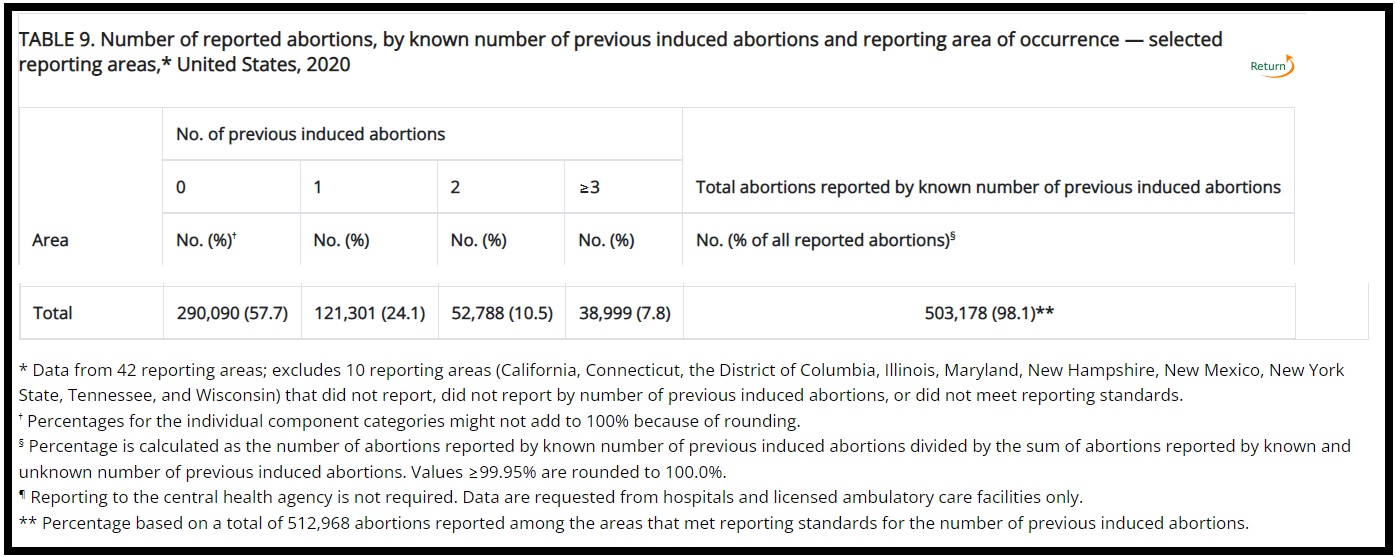
CDC 2020 abortion data on previous abortions
Data from those 42 reporting areas excludes “10 reporting areas (California, Connecticut, the District of Columbia, Illinois, Maryland, New Hampshire, New Mexico, New York State, Tennessee, and Wisconsin) that did not report, did not report by number of previous induced abortions, or did not meet reporting standards,” the CDC wrote.
A 2020 study published in the Journal of Health Services Research and Managerial Epidemiology found that aborting a first child makes a woman more likely to abort in future pregnancies.
Black women experienced higher abortion percentages, rates, and ratios
“Among the 30 areas that reported race by ethnicity data for 2020, non-Hispanic White women (White) and non-Hispanic Black women (Black) accounted for the highest percentages of all abortions (32.7% and 39.2%, respectively), and Hispanic women and non-Hispanic women in the other race category accounted for lower percentages (21.1% and 7.0%, respectively),” the CDC claimed.
“White women had the lowest abortion rate (6.2 abortions per 1,000 women aged 15–44 years) and ratio (118 abortions per 1,000 live births), and Black women had the highest abortion rate (24.4 abortions per 1,000 women aged 15–44 years) and ratio (426 abortions per 1,000 live births),” they wrote.
Breaking this down further, we found that for every 100 live births:
- Nearly 12 white babies will die by abortion.
- Nearly 43 Black babies will die by abortion.
- Just over 17 Hispanic babies will die by abortion.

Black abortion stats by race ethnicity CDC 2020
The most recent data on race published by the Guttmacher Institute is outdated as it is still from 2014, but even there, the data showed a disproportionate impact as well.
Abortion is tethered to eugenics, and the CDC’s 2020 data confirms that communities of color, which have a disproportionate number of abortions, are still being targeted for eugenic abortions. Read more on abortions by race/ethnicity here.
Black women had more abortions later in pregnancy than white or Hispanic women
In 2014, Guttmacher claimed that “women with less education, Black women and [w]omen who had experienced multiple disruptive life events in [the] past year” were more likely than others to have had an abortion at or beyond 13 weeks’ gestation.
According to CDC data, 319,195 abortions were categorized for race/ethnicity and gestational age. Out of that total number, the highest amount (93.8%) occurred between 0-13 weeks (299,508), while 6.2% were committed at 14 weeks or greater (19,687).
“In 28 reporting areas, by race or ethnicity, 80.1% of abortions obtained by Black women occurred at ≤9 weeks’ gestation, compared with 81.5% of non-Hispanic women in the other race category, 82.0% of White women, and 83.9% of Hispanic women,” the CDC wrote.
Conversely, the data also showed that in 2020:
- White women had nearly 93.7% of abortions reported for gestational age between 0-13 weeks of pregnancy (98,317) and 6.2% at 14 weeks or greater (6,560).
- Black women had nearly 93.6% of abortions reported for gestational age between 0-13 weeks of pregnancy (119,685) and 6.3% at 14 weeks or greater (8,103).
- Hispanic women committed nearly 94.5% of abortions reported for gestational age between 0-13 weeks of pregnancy (62,741) and 5.4% at 14 weeks or greater (3,633).
The data on race and gestation “excludes 24 reporting areas (California, Colorado, Connecticut, the District of Columbia, Hawaii, Illinois, Iowa, Louisiana, Maine, Maryland, Massachusetts, Nebraska, New Hampshire, New Jersey, New York City, New York State, North Dakota, Ohio, Oklahoma, Pennsylvania, Rhode Island, Tennessee, Washington, and Wisconsin) that did not report, did not report weeks of gestation by race or ethnicity, or did not meet reporting standards,” the CDC wrote.
Teens accounted for a higher number of later abortions
Data by age and gestation was recorded in 41 reporting areas, and revealed that young teens also accounted for a higher number of later abortions.
“Conversely, 18.7% of adolescents aged <15 years and 9.1% of adolescents aged 15–19 years obtained an abortion after 13 weeks’ gestation, compared with 6.3%–7.2% for women aged ≥20 years,” the CDC stated.
In every subgroup for these characteristics, the highest percentage of abortions occurred at ≤9 weeks’ gestation, the CDC report claimed.
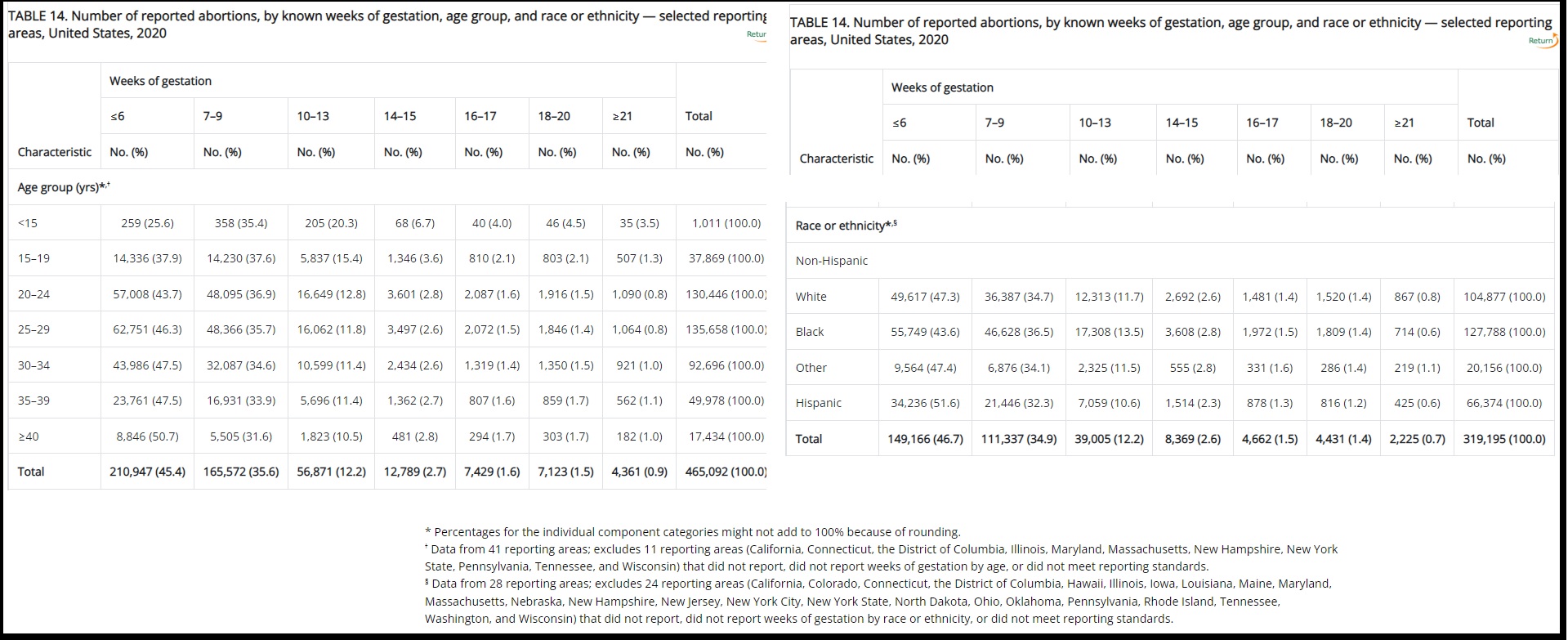
Abortions by gestation for age race and ethnicity CDC 2020
Additionally:
- Most had a low income.
- Most had at least a high school education.
- Most had some religious affiliation.
- Most paid for their abortions out-of-pocket.
These categories on abortion characteristics from the Guttmacher Institute in 2014 are outdated by years, but can be read here. Live Action News will update these categories as soon as more current information is published.

